A Tour of New York State’s COVID Alert NY App
In the morning on October 1st, I was innocently scanning through the haphazardly organized Settings app on my iPhone (see the still-apropos “Bad Apple #2: Alphabetize Settings in iOS,” 21 February 2018), when I noticed the Exposure Notifications option. I hadn’t checked back in since its initial release (see “iOS 13.7 Integrates Apple’s COVID-19 Exposure Notifications,” 1 September 2020), so I tapped through and was surprised to learn that New York State now has an app that’s compatible with the Apple/Google exposure notification technology. I pay close attention, but this was the first I’d heard of such an app. It turned out that I was just lucky—Governor Cuomo’s office announced the app officially later in the day. 9to5Mac has a list of all the US states and territories that are participating so far.
Getting the app proved a little more challenging. The Open App Store link brought up an App Store article that discussed the exposure notification technology and listed some apps but didn’t include the New York app it promised at the top. Hopefully, that has changed now; I can’t find the article anymore.
A search in the App Store revealed the COVID Alert NY app, and I was intrigued to see the extent to which the state emphasizes the privacy aspects of the technology and approach. Just look at how many times they mention privacy in the description. (Click an image to view it larger.)
The first screen of the app has a Learn How It Works link as well, which opens a four-screen tutorial that does an excellent job of summarizing the complex system that Apple and Google developed (for full details, see Glenn Fleishman’s “Apple and Google Partner for Privacy-Preserving COVID-19 Contact Tracing and Notification,” 10 April 2020, and David Shayer’s “Former Apple Engineer: Here’s Why I Trust Apple’s COVID-19 Notification Proposal,” 11 May 2020).
Back at the initial screen, tapping the Get Started button walks you through an explanation of why the app has to ask for COVID-19 exposure logging and notifications, presents those permission requests, and then confirms that it’s all set up.
It even offers a Share button that, when I used it to send myself a text message, generated a message and provided a link to a COVID Alert NY Web page (which continues to hammer home the privacy protections). If you’re a New Yorker and get the app, I strongly encourage you to share it broadly with your family, friends, and colleagues. (There’s an Android version as well, so you don’t have to worry about confusing your green-bubble friends with an iOS app.)
To give you a reason to load the app regularly, which is helpful for keeping the entire concept of exposure notification fresh in users’ minds, the app provides three graphs for both the state as a whole and for each county. The graphs show the percent of COVID-19 tests that have come back positive, the total number of positives, and the total number of tests performed, all across the last month.
All three numbers are useful because they show the differences even across nearby counties. For instance, I live in Tompkins County, where we had a spike in early September related to thousands of Cornell University students returning to campus. Cornell quickly brought that under control with excellent contract tracing and quarantining of exposed students, and our infection rate is back to well under 1%. The more rural neighboring Tioga County, where I grew up and which has about half the population, has notably higher infection rates. However, a look at the other graphs shows that it’s testing only a few hundred people per day, whereas Cornell’s aggressive regime of testing every student twice per week means that Tompkins County was doing more than 5000 tests most days and is now averaging nearly 10,000 per day.
The next major area of the app, accessed during setup and via a button in the bottom toolbar, is My Health Log, which helps you keep track of your own health and provide anonymized data for public health researchers. Users are encouraged to report in every day, presumably to help provide a baseline should symptoms crop up.
The final part of the app revolves around what to do if you test positive for COVID-19. The app tells you to stay at home and isolate yourself for 14 days, after which it explains that a public health representative will call with more information and ways you can get help. They’ll also ask if you’re willing to share your app’s list of close contact codes, and if you are, they’ll give you a six-digit number that triggers the upload of your codes so others can be notified—completely anonymously!—that they might have come in contact with you.
That’s it, apart from an App Settings screen that lets you change your mind about anything you’ve said during the setup. I was also pleased to see an additional focus on privacy, including the opportunity to delete your data, a summary of the privacy policy with a link to the full policy, and a feedback mechanism for technical issues, supplemented with phone numbers for anyone who is feeling sick or has questions.
Overall, I’m impressed. The app is clear, clean, and polished, and does a fine job at giving users a reason to install it beyond the civic duty of helping protect fellow New Yorkers. I hope similar apps from other states and countries are at least as good, and if you’ve used one, let us know what it’s like in the comments.
And, of course, if you live in New York, please install and configure the app to help protect yourself, those close to you, and others in your community!
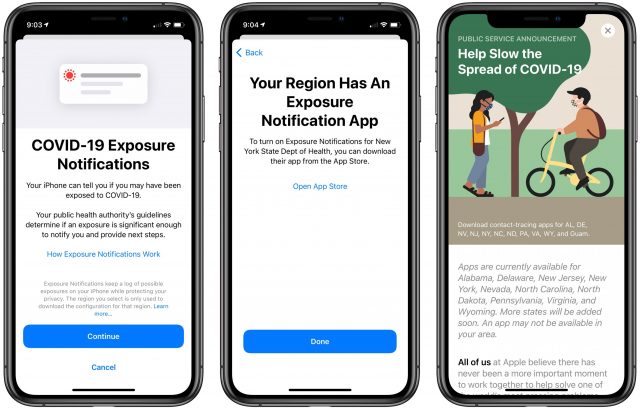
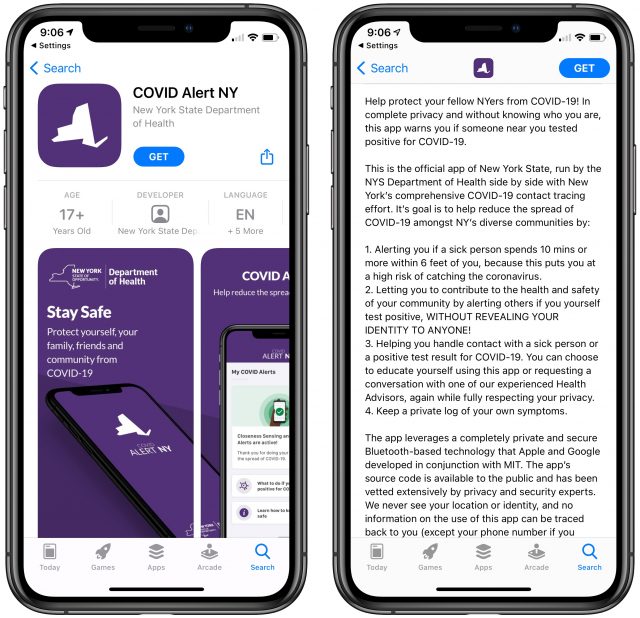
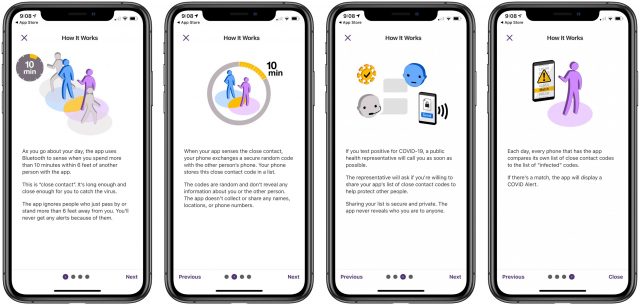
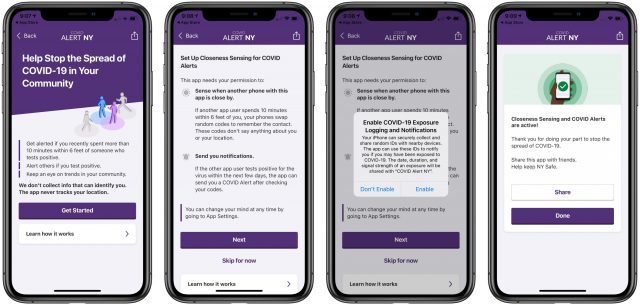
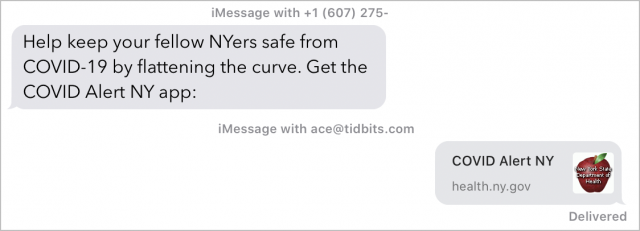
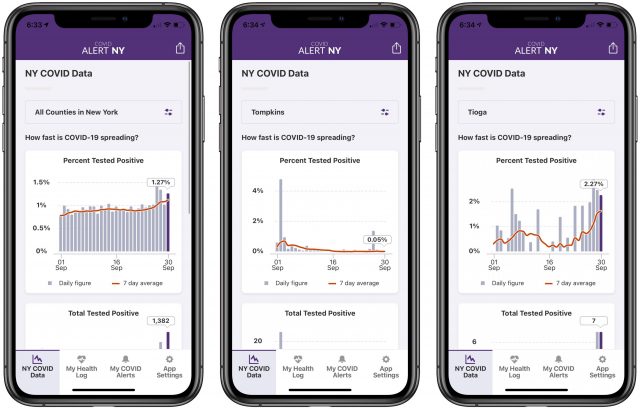
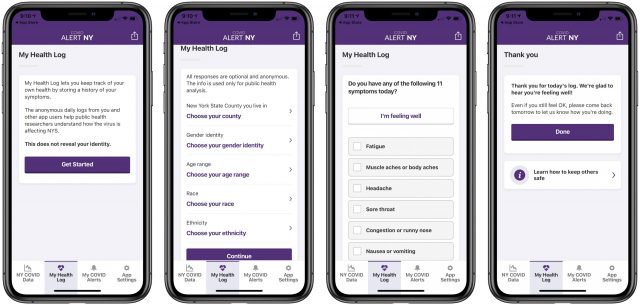
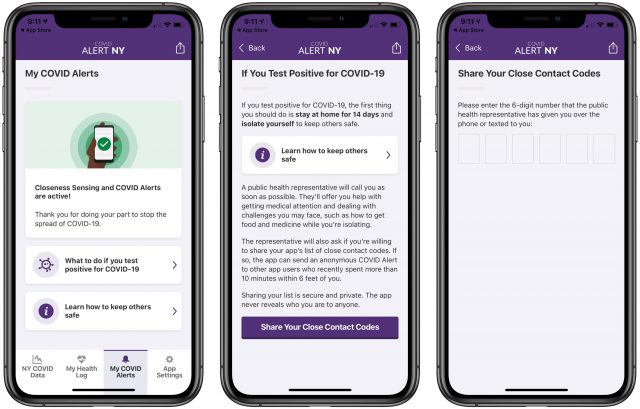
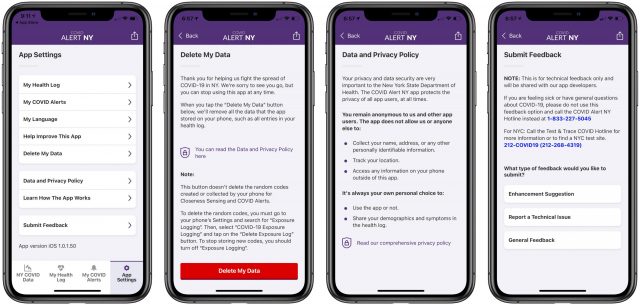
I saw the same thing in Settings, but didn’t realize that it meant NY was participating until I read this article.
Going to turn it on now and then send it to the rest my family.
Thanks for this article. It caused me to investigate, and of course I have questions.
(But first, how do I quote a snippet from an article, with attribution, in a reply?)
Apparently my state does not have an app (after selecting my state, the setting said my region had an app, but the App Store disavows all knowledge), but the state I can see out my back door does. Is there any reason I should not download that state’s app? Could I run two states’ COVID alert apps?
There is a switch called Availability Alerts. If I turned that on, would it notify me when an app became available?
The switch is grayed out, with the text below it explaining that it is not available because Location Services is turned off. Aside from the poor user interface that doesn’t link to Location Services or even tell me where Location Services is located (maybe you should write an article about the poor layout of iOS Settings, @ace), Location Services (which is located under the Privacy settings, in case anyone wonders) is turned on. Might it mean that Share My Location, a setting under System Services, is turned off? Or some other sub-setting?
As you can see, I have lots of confusion. Please help me out. Thanks.
I turned it on in Settings as it was mentioned in the NYTimes this morning. But turning it on didn’t cause the app to download, so I headed over to the App Store. I will also alert friends and family.
There’s no automatic way. Just copy the text and prefix it with >. It looks as though you figured that out.
You mean like Bad Apple #2: Alphabetize Settings in iOS?
Location Services is in Settings > Privacy > Location Services and generally speaking, it should be on. You can control it independently for apps on that screen.
As far as not seeing an app for your state, look in the 9to5Mac list.
https://9to5mac.com/2020/10/01/covid-19-exposure-notification-api-states/
Yep, an app is always necessary.
Yes to the location (but I said that, albeit not a clearly as you), yes to having it on (but I said it already was on).
Are you saying the Availability Alerts are related to an app’s behavior (rather than, as I wondered, the existence of an app)? If so, that would explain why it is gray, but not why the gray is explained as Location Services being turned off (when it isn’t).
Honestly, I don’t know. It’s difficult to troubleshoot problems related to something that’s not appearing for another person, particularly when it’s a new situation. You don’t say what state you’re in, so there’s no way to know if it has a supported app or if there might be other technical issues related to your state.
In England we have had the NHS Covid app which uses the same Apple and Google tech since 24 Sept. it is linked to the England Test and Trace system which means that all venues have to have a QR code on display which you are expected to scan with the App to log in to the location When you arrive. Should there be a covid case reported by someone who visited at the same time you will get an alert through the app. It also does the Bluetooth check in background using the Apple tech and allows you to request a covid test and automatically alerts you about the test outcome. A similar app is available in Scotland but they have had it a while longer.
Checked the list on 9to5Mac, but have a question. What is the difference between EN Express and an Apple/Google compatible app?
After researching this a bit, I think “EN Express app in development” is just their shorthand for “the state has said that it is working on an app.” I don’t believe there is an explicit “EN Express” app. But I could be wrong!
Thanks, Adam. I was curious because it surprised me that California doesn’t have a compatible app.
The phrase “EN Express app in development” doesn’t really make sense. From the first paragraph of Apple’s description of Exposure Notification Express: “iOS 13.7 and later can inform people of potential exposure to COVID-19 without a dedicated Exposure Notifications app. This app-less functionality is called Exposure Notifications Express and is only available when a Public Health Authority (PHA) supports it.”
Much as I have issues the Cupertino, I carefully went over their description (from weeks ago) of the API especially as it applies to privacy. Everything seemed very much on the money (I’ll take it on faith they weren’t flat out lying). Soon as I heard the NYS app was out, I hjeaded to the App Store, got it, configured it (was pretty simply to set up I thought).
One cool thing is it gives you a daily picture & a 7 day average of how many tested and how many positive (they generate the percentage for you). Even cooler, it’s not for the whole state but is narrowed down… in my case it’s THE ONE borough in NYC I live in, so it’s reasonably local (the state does track by zip codes). Even so, it would be WAY nice is they tracked by zip code, the state obviously has the data.
Frankly, my phone is more of an emergency contact device that I got because my sister and I were taking care of a very elderly family member, and may have need to communicate in all circumstances. Came in hand maybe half a dozen times in 2-3 years. So now it mostly sits at home and gets used once in a blue moon if my cable service goes on the fritz (got VOIP through them). NOW I gotta try and aways strap it in whenever I go outside.
HOWEVER, it is only really useful if everyone got it, set it up, had it always on them AND reported if they tested positive. With the anti-vaxxers, anti-maskers, believers being told the virus is “deep state, democratic party hoax,” or that it’s no big deal, who hear about 210,000 dead and shrug and intone “fake news,” we just do not and never really could have the kind of critical mass that this tech NEEDS in order to be effective. Back in Feb/Mar I read about the success with contact tracing and kinda reasoned that WOULD be an effective way to keep it at bay. Some idiot here made it a political issue and suckered in way too many people. I have little skin in the game as I am an “old f**k” as George Carlin once said, but I get riled up because I have a LOT of friends who have children down to 2-3-4 years old. If everyone adopted this tech, we at least stand a chance at NOT seeing 3-400K dad before we look around.
Oh, trust me, I drag my phone around whenever I leave the front door. It stands ready to say hello to any other iOS device using it.
Thanks for installing the app and taking your phone with you when you go out!
I think all we can do is encourage our friends and relatives to use it, and emphasize that it’s just one more tool in the arsenal that society is gradually building up against the coronavirus. No one thing will solve the fix we’ve ended up in, but cooperation in many different ways will beat it in the end.
I’m trying, sent the link to everyone I know who runs iOS… my bet is most of them will install. AND this IS a double edged sword… I’ll be happy to receive a notification, AND I am a triple threat for death, “old f**k,” nearly kicked it from a pulmonary embolism last fall, AND 3 months since my chest was cracked open.!
I have a question about these COVID Alert apps. Do you need to be a resident of a state to use the app from that state? If you are visiting someone in another state that has an app, can you and does it make sense to download and setup the app while you’re visiting? If you are regularly in two different states, can you have two versions of the app active at once?
Why not? There is no question about your residence, the notifications if any will be sent to you via the phone. I installed it while (now) in Netherlands, before returning to NY State in a month, there was no restriction. If someone else here has installed the NY app I think it would track the contact. It uses bluetooth (local) not GPS. The info on infections etc. (very nice, as Adam says) is of course NY specific to its counties.
If they work the way the Virginia app does (and I assume everything using the Apple or Google APIs do), the answer is “yes, but…”
Anybody can run the app. It will generate random IDs for you and exchange those IDs (via Bluetooth) with anybody you come near, alerting you if you were near someone reported as having had a positive test.
But each state runs its own reporting system. You need a code from the state that issued the app in order to report yourself as having had a positive test. If you get tested in another state, then it may be difficult or impossible to get that code.
It’s also unclear to me if the database of IDs associated with positive tests is global or local to each state. If it’s local, then the New York app isn’t going to alert you if you came close to someone who tested positive but reported his diagnosis with another state’s app.
In general, if you want to use a contact tracing app, you really should use the app issued by the state where you live. If you want to install apps from other states as well, it should work, but I don’t think it will be useful except when you’re traveling to those states.
There is an effort by the Association of Public Health Laboratories to facilitate interoperability of the system between states.
It looks like the iPhone only lets you have one region active at a time…but what happens if I live in an area that borders two or three states?
If I have both the NY and NJ apps, with the NJ app being active - will I get a notification if someone I’ve been around enters a positive code in NY?
Arizona has an app available, but it is still a work in progress. They have full functionality for two of the universities (UA and NAU) but do not have reporting capability for the rest of the state yet.
I am impressed with the additional detail that the NY version provides and hope it becomes common across all the states (along with interoperability)
I can envision the app being used (along with a temperature measurement) for admittance to group events as an alternative to a COVID-19 antigen test.
Here is what I would like to see added to the Arizona app.
Regrettably I do not see or expect widespread acceptance of this technology. Hence my approach of getting into an event is take a 15 min COVID test (for an additional fee) or show the app as a motivator.
I have been sharing the app availability to others with mixed reactions from interest, to I have it but I didn’t turn it on, to active avoidance of me like I was infected. This tells me there is a lot of effective communication needed to make people aware of the technology and to use it.
I hope this will become an effective tool in our effort to combat COVID.
Alas, I don’t think this would work. Aside from the fact that temperature checks are largely worthless, the app’s alerts wouldn’t necessarily happen in time. For instance, let’s say you’re exposed to someone who’s infectious and is also using the app. It might take several more days for them to show symptoms (if they ever do) and get tested, unless they’re a student at a place like Cornell that’s doing twice-weekly surveillance testing (extremely successfully). Even if they do show symptoms, get tested, and report to the app, such that it could notify you, it could easily be several days after you had contracted COVID-19 (again, possibly with no symptoms).
The utility of the alerts is not that their lack gives you an all-clear, but that if you do get one, you know to go get tested right away.
I think that’s a great suggestion. It encourages use and gives you feedback that it would alert you if there was a problem.
I really like reporting to the COVID Alert NY app that I’m feeling well every day.
I haven’t gotten any pushback from anyone I’ve told about it, but very few people have known about it or understood how it worked.
Sadly it looks like people are also avoiding testing. See JAMA COVID Testing Hesitancy.
Our old friend Rob Pegoraro wrote about this for USA Today recently. Adoption is low. Which I find frustrating given the privacy-abusing crud that it seems everyone will install without a thought.
I’ve had Pennsylvania’s app installed and activated since it came out. It provides a quick way of seeing how things are progressing in PA on a county by county basis. I’ve also had the NOVID app installed, but I’m apparently the only one in the 168 group of ZIP codes, so of course I’ve never seen an interaction. I got my second dose of the Pfizer vaccine a week ago, so next week I might just turn COVID tracking off.
In California, I haven’t seen any sort of advertising about exposure notification, so I’m not surprised the adoption rate is so low. I wonder how many people even know about it.
Fair point. The only reason I heard about it was because the UC system was used as a testbed during development so we got roped in early to serve as guinea pigs.
There’s covid19.ca.gov, but surprisingly you have to explore the site map there to even find a link to CAnotify.ca.gov which advertises it.
Agreed. New York pushed the COVID Alert NY app briefly. I saw it mentioned just five times in the New York briefing email messages that the Cuomo administration sends out every day, and only in October and early November. Silence since then.